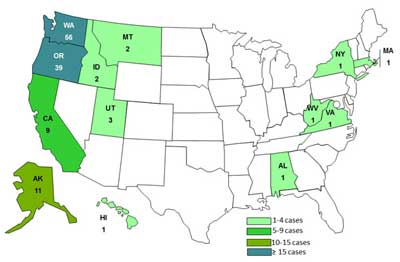A Salmonella outbreak linked to chicken produced by Foster Farms has sickened 128 people in 13 states, according to the latest information from the Centers For Disease Control and Prevention (CDC). Most of the cases are in Washington (56) and Oregon (39), a total of 32 people have been hospitalized.
 Health officials in Oregon and Washington have identified Foster Farms brand chicken as the most likely source of the 95 infections in those states. The company has not issued a recall.
Health officials in Oregon and Washington have identified Foster Farms brand chicken as the most likely source of the 95 infections in those states. The company has not issued a recall.
Salmonella can cause serious illness. Symptoms of an infection, called salmonellosis, include fever abdominal cramps and diarrhea, which usually develop 12 to 72 hours after infection and last four to seven days. If the infection spreads to the bloodstream, it can cause death unless the person is treated promptly with antibiotics.
Tests conducted by the Washington State Public Health Laboratories have identified the outbreak strain of Salmonella Heidelberg in four intact samples of chicken collected from the homes of three case patients. An investigation by the U.S. Department of Agriculture Food Safety and Inspection Service (USDA-FSIS) is ongoing.
Case counts by state for the outbreak, which began June 4, are as follows: Alabama (1), Alaska (11), California (9), Hawaii (1), Idaho (2), Massachusetts (1), Montana (2), New York (1), Oregon (39), Utah (3), Virginia (1), Washington (56), and West Virginia (1). Since the initial announcement on February 14, four new cases have been reported from Alabama (1), California (2), and Oregon (1).
Interviews with case patients indicate that onset of illness dates range from June 4, 2012 to February 4, 2013. Those sickened range in age from less than 1 year to 94 years old, with a median age of 22. Most of those sickened, 55 percent, are female.
The National Antimicrobial Resistance Monitoring System (NARMS) retail meat surveillance program is a collaboration among the U.S. Food and Drug Association Center for Veterinary Medicine, the CDC, and participating state public health laboratories. It monitors antibiotic resistance in Salmonella, Campylobacter, Enterococcus, and Escherichia coli isolated from raw unprocessed retail meats. From 2002 to 2011, NARMS found Salmonella in about 13 percent of retail chicken samples tested. (1,503 out of 11,417) “Salmonella Heidelberg was identified in 233 retail chicken samples tested by 11 state public health laboratories. Among these 233 isolates, 48 (21%) matched the outbreak strain, and 47 (98%) of those were isolated from Foster Farms retail chicken samples,” according to the CDC report.
NARMS also performed tests for antibiotic resistance on isolates collected from 14 outbreak case patients and the four intact samples of chicken taken from some of their homes. All but two of the isolates from case patients were susceptible to antibiotics. The two that weren’t were resistant to multiple antibiotics, including amoxicillin/clavulanic acid, ampicillin, and ceftriaxone. “Ceftriaxone is commonly used to treat invasive Salmonella infections and is particularly important for treating such infections in children,” according to the report. All but one of the isolates fro the chicken samples responded to antibiotics. The other one was resistant to gentamicin, streptomycin, and sulfisoxazole. People sickened with antibiotic-resistant Salmonella may not respond to treatment or may have more severe infections than others, according to the CDC.





I eat chicken sushi all the time…is it best to cook it?
If the chicken in the sushi is raw, that’s a terrible risk you’re taking. Chicken should never be eaten raw. Almost half of the chickens sold in this supermarket in this country are contaminated with feces. Campylobacter bacteria is on half of all chicken sold in this country too. Consumer Reports found that most broilers they tested were contaminated with Salmonella and Campylobacter. People who eat COOKED chicken get sick because it was undercooked or improperly handled.